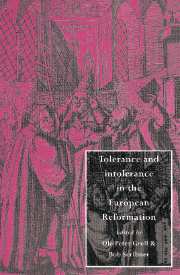Book contents
- Frontmatter
- Contents
- List of contributors
- Preface
- Dedication
- 1 Introduction
- 2 The travail of tolerance: containing chaos in early modern Europe
- 3 Preconditions of tolerance and intolerance in sixteenth-century Germany
- 4 Heresy executions in Reformation Europe, 1520–1565
- 5 Un roi, une loi, deux fois: parameters for the history of Catholic-Reformed co-existence in France, 1555–1685
- 6 Confession, conscience and honour: the limits of magisterial tolerance in sixteenth-century Strassburg
- 7 One Reformation or many? Protestant identities in the later Reformation in Germany
- 8 Toleration in the early Swiss Reformation: the art and politics of Niklaus Manuel of Berne
- 9 Tolerance and intolerance in sixteenth-century Basle
- 10 Exile and tolerance
- 11 The politics of toleration in the Free Netherlands, 1572–1620
- 12 Archbishop Cranmer: concord and tolerance in a changing Church
- 13 Toleration for Catholics in the Puritan revolution
- 14 The question of tolerance in Bohemia and Moravia in the age of the Reformation
- 15 Tolerance and intolerance in sixteenth-century Hungary
- 16 Protestant confessionalisation in the towns of Royal Prussia and the practice of religious toleration in Poland-Lithuania
- Index
14 - The question of tolerance in Bohemia and Moravia in the age of the Reformation
Published online by Cambridge University Press: 07 December 2009
- Frontmatter
- Contents
- List of contributors
- Preface
- Dedication
- 1 Introduction
- 2 The travail of tolerance: containing chaos in early modern Europe
- 3 Preconditions of tolerance and intolerance in sixteenth-century Germany
- 4 Heresy executions in Reformation Europe, 1520–1565
- 5 Un roi, une loi, deux fois: parameters for the history of Catholic-Reformed co-existence in France, 1555–1685
- 6 Confession, conscience and honour: the limits of magisterial tolerance in sixteenth-century Strassburg
- 7 One Reformation or many? Protestant identities in the later Reformation in Germany
- 8 Toleration in the early Swiss Reformation: the art and politics of Niklaus Manuel of Berne
- 9 Tolerance and intolerance in sixteenth-century Basle
- 10 Exile and tolerance
- 11 The politics of toleration in the Free Netherlands, 1572–1620
- 12 Archbishop Cranmer: concord and tolerance in a changing Church
- 13 Toleration for Catholics in the Puritan revolution
- 14 The question of tolerance in Bohemia and Moravia in the age of the Reformation
- 15 Tolerance and intolerance in sixteenth-century Hungary
- 16 Protestant confessionalisation in the towns of Royal Prussia and the practice of religious toleration in Poland-Lithuania
- Index
Summary
In the lands of Bohemia, the problem of religious tolerance at the turn of the Middle Ages and the pre-modern age is indissolubly linked with Hussitism. In the peak period of its activities, between the years 1419 and 1434, this movement brought about an overthrow of the traditional political and ecclesiastical situation, living further on, in a moderate and transformed manner, up to the first quarter of the seventeenth century. Hussitism is justly referred to as the first, or Czech Reformation, as against the second, German or European Reformation, coping with similar problems as the Hussites within a much broader geographical range during the sixteenth century. Elaborating on the doctrine of John Wyclif and applying it in its social practice, Hussitism resolutely suppressed the Catholic Church and stripped it both of its landed property and of its political power in Bohemia and partly also in Moravia. The arguments of Hussitism were persuasive enough to win over an absolute majority of the country's population including major segments of the nobility and burghers. However, Catholicism managed to hold its positions in the border regions of Bohemia, partly in Moravia and, to retain a dominant position, in the remaining three lands of the Crown of Bohemia (Silesia and Upper and Lower Lusatia), throwing up a rampart which held back the onslaught of Hussitism. The population of the state of Bohemia split into two long-term confessional and political camps faced essentially with two possibilities – either to go on fighting until the total elimination of the weaker adversary or to seek a path towards coexistence and mutual tolerance.
- Type
- Chapter
- Information
- Tolerance and Intolerance in the European Reformation , pp. 231 - 248Publisher: Cambridge University PressPrint publication year: 1996
- 45
- Cited by



